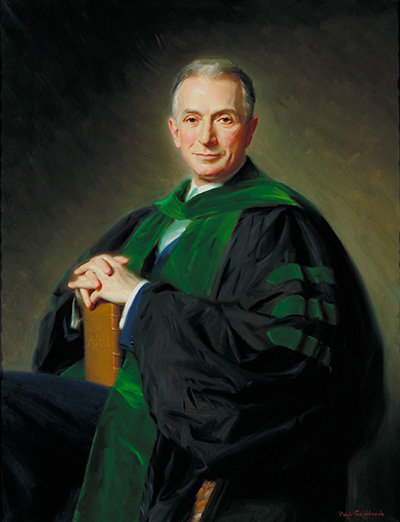Arnold Rice Rich

Arnold Rice Rich
- Artist:
- Paul Trebilcock
- Date:
- 1958
- Medium:
- Oil on canvas
- Dimensions:
- 44 x 33.5 in.
Arnold Rice Rich
1893-1968
Rich, a director of pathology at Johns Hopkins, was born in Birmingham, Alabama. He attended the University of Virginia, where he received his B.A. in 1914 and his M.A. in 1915. Rich received his M.D. from the Johns Hopkins University School of Medicine in 1919. In response to World War I, the medical students were regimented into the Johns Hopkins Unit of the Students Army Training School in the fall of 1918. After this experience, Rich decided to specialize in experimental surgery. However, William Halsted suggested a year of training in pathology before he would take Rich as a surgical intern. Rich studied under William McCallum and switched his specialization to pathology. In 1919, he was appointed assistant in pathology.
In 1923, he was appointed associate professor in pathology and would remain at Johns Hopkins for the rest of his career. In 1944, Rich was promoted to professor of pathology and in 1947 was named the Baxley Professor of Pathology and director of the department. He also served at The Johns Hopkins Hospital for nearly 40 years, retiring as pathologist-in-chief in 1958.
Rich had varied research interests. His early work focused on the formation of bile pigment and the causes of jaundice, finding that there were two main pathways to the development of the disease. He then turned his attention to studying the relationship between hypersensitivity and immunity, especially in regards to tuberculosis. This work led to the publication of Rich’s Pathogenesis of Tuberculosis, a classic text in its field.
Through other research efforts, Rich was among the first to describe the high prevalence of occult cancer of the prostate in elderly men, the first to describe lymphoid polypoidal structures in kidney tubules which he attributed to syphilis, and the first to describe widespread pulmonary vascular obstruction in children with tetralogy of Fallot. With his long time clinical associate Louis Hamman, he described a unique pulmonary interstitial lesion as part of what has become known as the Hamman-Rich syndrome. He also discovered the phagocytic function of the Gaucher cell, the hallmark of Gaucher’s disease.
Rich contributed his expertise to the Chemical Warfare Service, the Surgeon General of the Army, and the Tuberculosis Control Division of the US Public Health Service. His research and practice garnered him many honors. He was a member of the National Research Council from 1947 to 1952. In 1951, he became the Chairman of the Scientific Advisory Board of the Armed Forces Insitutes of Pathology. He was elected a member of the National Academy of Sciences in 1954. His awards include the Kober Medal of the Association of American Physicians, the Gordon Wilson Medal of the American Clinical and Climatological Association, and the Trudeau Medal of the National Tuberculosis Association.
"*" indicates required fields
